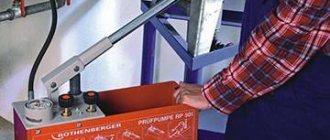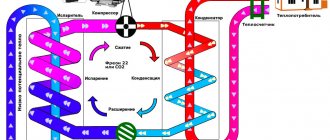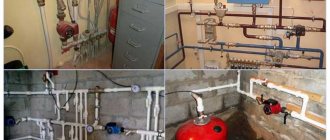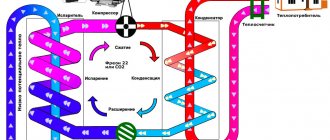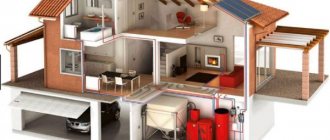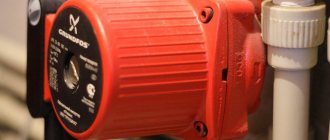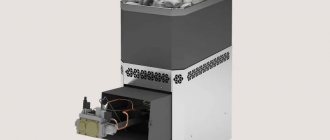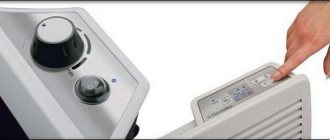In order for the water supply system to work uninterruptedly, the main thing is to choose the right pump.
Pumps are used to supply water from a well or well or to recirculate it. In order for the system to work efficiently and uninterruptedly, and also in order not to overpay for a model with excessive characteristics, they need to be selected. Let's consider how to calculate a pump for water supply and select the parameters of these units.
How to determine the required pressure of the circulation pump
The head of centrifugal pumps is most often expressed in meters.
The pressure value allows you to determine what hydraulic resistance it can overcome. In a closed heating system, the pressure does not depend on its height, but is determined by hydraulic resistance. To determine the required pressure, it is necessary to perform a hydraulic calculation of the system. In private homes, when using standard pipelines, as a rule, a pump that develops a pressure of up to 6 meters is sufficient. You should not be afraid that the selected pump is capable of developing greater pressure than you need, since the developed pressure is determined by the resistance of the system, and not by the number indicated in the passport. If the maximum pressure of the pump is not enough to pump liquid through the entire system, there will be no circulation of liquid, so you should choose a pump with a headroom reserve
.
Classification of gear pumps
There are many types of gear pumps, differing from each other in various ways:
- by the nature of engagement with internal gearing
- with external (external) gearing
- with straight teeth - straight teeth
- right rotation
- two-rotor
- single stage
- adjustable
- unloaded
The presented classification is conditional and may not cover some less common or promising developments.
When analyzing the features of a pump, you should not limit yourself to classification according to only one criterion, since its operation depends on many factors.
Gear pumps with internal gearing have a significantly lower noise level and pulsation, but their production is much more expensive; pumps of this type are most often used in stationary machines - presses, machine tools. You can read more about the design and features of these hydraulic machines in the article internal gear pumps.
Single stage external gear pumps
Pumps of this type are widely used in technology; such pumps are especially often used in hydraulic drives of mobile machines.
Recommendations for calculating pump power for water wells.
Sometimes people ask the following questions: recommend a good pump for a well, since the old one no longer copes with its task.
Answers to the most common questions will be given below in the form of recommendations from experts.
1. When choosing a pump, try not to give preference to options with vibration, although their price is lower. This type of equipment is more suitable for ordinary wells, since their communications are covered with sand over time.
2. It is better to choose centrifugal type submersible pumps. This will prevent the well from filling up with sand.
3. To obtain better quality water, install the pump at a distance of at least 1 m from the filter.
4. When using water, it is necessary to take into account not only average values, but also peak values. Also make sure that there is enough water for technical purposes (watering the garden, washing the car, etc.).
5. To ensure good water pressure, you must select a pump with a power reserve of 20% of the selected value. This will create excess pressure in the system and provide excellent water pressure. Factors such as silting of water pipes and the use of filters contribute to a decrease in pressure. It will not be possible to carry out this type of calculation yourself without the necessary knowledge and skills, so it is better to turn to professionals for help.
6. Try to lower the pump 1 m below the dynamic water level. This measure will prevent the engine from being cooled by water coming from outside.
7
To protect against power surges, it is recommended to install stabilizers, since for a submersible pump it is very important that the network has a stable voltage and current. This will further protect your equipment and extend its service life.
8
Please note that the diameter of the pump must be at least 1 cm smaller than the diameter of the well itself. This will extend the life of the pump and simplify the procedure for installing/dismantling equipment
For example, if a well has a diameter of 76 cm, then the pump must be selected with a diameter of no more than 74 cm
For example, if a well has a diameter of 76 cm, then the pump must be selected with a diameter of no more than 74 cm.
Why are calculations needed?
Most modern autonomous heating systems, used to maintain a certain temperature in residential premises, are equipped with centrifugal pumps that ensure uninterrupted circulation of liquid in the heating circuit.
By increasing the pressure in the system, it is possible to reduce the temperature of the water at the outlet of the heating boiler, thereby reducing the daily consumption of gas consumed by it.
The correct choice of the circulation pump model allows you to significantly increase the level of equipment efficiency during the heating season and ensure a comfortable temperature in rooms of any size.
Defining Variables
The performance of a centrifugal pump is affected by the following components:
- water pressure;
- required power consumption;
- impeller size;
- maximum liquid suction height.
So, let's look at each of the indicators in more detail, and also provide calculation formulas for each of them.
Calculation of the performance of a centrifugal pump unit is carried out according to the following formula:
W = l1*(n*d1 – b*n)*c1 = l2*(n*d2 – b*n)*c2
The designation of this formula is as follows: W – pump performance, measured in m3/s; l1,2 – width of the impeller according to diameters d1,2; d1 – diameter of the suction pipe; d2 – impeller diameter; b – thickness of the impeller blades; n – number of blades; p – number “pi”; с1,2 – meridian sections of the inlet and outlet pipes.
You may be interested in an article on the classification of centrifugal pumps.
Read the article about centrifugal self-priming pumps here.
The water pressure created by a centrifugal pump is calculated by the formula:
N = (h2 – h1)/(p * g) + Ng + sp
The variables in the formula indicate: N – head height, measured in meters; h1 – pressure in the liquid intake tank, measured in Pa; h2 – pressure in the liquid receiving tank; p – density of the liquid that is pumped by the pump, measured in kg/m3; g is a constant value indicating the acceleration of gravity; Ng – indicator of the required height of liquid rise; sp – sum of fluid pressure losses.
The required power consumption is calculated using the following formula:
M = p*g*s*N
The formula variables mean: M – required power consumption; p – density of the pumped liquid; g is the magnitude of the acceleration of free fall; s – required volume of liquid flow; N – pressure height.
The maximum liquid suction height is calculated by the formula:
Nv = (h1 – h2)/(p * g) – sp – q2/(2*g) – k*N
The designation of the variables is as follows: Nv – liquid suction height; h1 – pressure in the intake tank; h2 – fluid pressure on the impeller blades; p – density of the liquid being pumped; g – free fall acceleration; sp is the amount of losses in the incoming pipeline due to hydraulic resistance; q2/(2*g) – liquid pressure in the suction line; k*N – losses depending on the added resistance; k – cavitation coefficient; N is the pressure created by the pump.
Operating principle
In order to correctly calculate a unit of this type, first of all, you need to know on what principle this device works.
The operating principle of a centrifugal pump consists of the following important points:
- water flows through the suction pipe to the center of the impeller;
- the impeller placed on the impeller, which is mounted on the main shaft, is driven by an electric motor;
- under the influence of centrifugal force, water from the impeller is pressed against the inner walls, which creates additional pressure;
- under the created pressure, water exits through the discharge pipe.
Please note: in order to increase the pressure of the exiting liquid, it is necessary to increase the diameter of the impeller or increase the engine speed.
Block pumping stations from the manufacturer
Can installation affect the pressure value?
Considering the simplicity, even primitiveness of the design of the pumps, as well as the availability of detailed installation instructions, many modern men take on the work on their own, that is, without the help of professionals. This behavior is most often associated with the desire to save money: not everyone is willing to pay not only for a pump or pumping station, but also for the services of a specialist. Considering that the pump's pressure is the main characteristic of its operation, no one is ready to lose. That is why the question suggests itself: to what extent can installation carried out independently affect the amount of pressure.
It would seem that we connect one pipe to the suction pipe, the other to the one responsible for the pressure, supply power - and you're done. In practice, the slightest mistake can not only negatively affect the water pressure, but also significantly reduce the duration of work.
What type of accumulator is needed?
Hydraulic accumulator selection table.
To select the right pump, you need to pay attention to which hydraulic accumulator will be used. Its purpose is to accumulate a certain volume of water to prevent the pump itself from turning on frequently. When a certain volume of water is reached, the pump turns off until the water is used up
Each pump has a permitted number of starts per hour, which is not recommended to be exceeded
When a certain volume of water is reached, the pump turns off until the water is used up. Each pump has a permitted number of starts per hour, which is not recommended to be exceeded.
Typically these are 20 starts, which, in the absence of a hydraulic accumulator, will be carried out every time the tap is opened. But if there is a tank, such inclusions will be rare, which will extend the service life of all equipment.
- Qmax is the maximum value of water flow;
- Pset – pressure when the pump is turned on;
- ΔР is the difference that is observed when the pump is turned on and off;
- Nmax is the permissible number of switches on and off per hour, usually indicated by the manufacturer for each model separately;
- K = 0.9.
When choosing a pump, it is necessary to take into account that the pressure of the air mass in it is always 0.8-0.9 bar.
Why in meters?
A pump for water pressure and any other liquid is a very popular device, without which it is difficult to imagine life in a private home. Many consumers still do not understand why pressure is measured in meters.
The pressure of a centrifugal pump, like any other, is usually measured in meters. Of course, such a system raises many questions. First of all, this has happened historically; everyone has long been accustomed to this designation and does not intend to change anything. And, of course, this is convenient, because you don’t have to resort to using other units of measurement or make complex mathematical calculations. The amount of pressure, calculated in meters, gives us information that the pump can lift the liquid to a given height.
Submersible pump pressure
That is why a submersible pump is considered one of the safest and most reliable. Its pressure is calculated by the formula:
H = H height + H losses + H spout, where:
H height - height difference between the location of the pump and the highest point of the water supply system;
H losses - possible hydraulic losses that occur when liquid moves through a pipe; they are primarily associated with friction of the liquid against the walls of the pipe;
H spout is the pressure on the spout that allows you to use all plumbing fixtures (usually in the range of 15-20 meters).
We have already established that the pump head is the pressure required to push the liquid to a given height. Circulation pumps have found themselves in heating systems; it is with their help that the uninterrupted circulation of the heat source in the system is ensured
Of course, it is necessary to approach the choice of a circulation pump more consciously and demandingly, understanding that the efficiency and uninterrupted operation of its use largely depends on this, which is so important for apartment buildings. Such pumps are reliable, efficient and have shown excellent performance even in apartment buildings. Of course, such a pump should also be selected based on the pressure
The pressure of the circulation pump has no connection and, accordingly, no dependence on the height of the building. The main thing here is the hydraulic resistance of the route. And here for the calculation you will need the following formula:
Of course, such a pump should also be selected based on pressure. The pressure of the circulation pump has no connection and, accordingly, no dependence on the height of the building. The main thing here is the hydraulic resistance of the route. And here for the calculation you will need the following formula:
H = (R * L + Z sum) / (p * g), where:
R - losses;
L is the length of the pipeline, measured in meters;
Z sum - the total number of the safety factor for the structural elements of the pipeline (for fittings and fittings this value is 1.3; for thermostatic valves - 1.7; and for mixers - 1.2);
p is the density of water, we remember from the school physics course that it is 1000 kg/m3;
g is the acceleration due to gravity, the value of which is taken as an average value of 9.8 m/s2.
It turns out that, knowing all the basic parameters, it is quite simple to determine the water pressure that you need in a particular situation; for this you do not have to involve specialists.
Gear pump brands
Let's look at the list of the most common brands of gear pumps:
External (external) gear pumps.
- NS
- G11
- NMS
- G.P.
- HY/ZFS - Bosch
- 1PF2G2 - Rexroth
- IPH - Duplomatic
- X1P - Vivolo
- GHP - Marzocchi
Brands and manufacturers of internal gear pumps
- PGF3 Rexroth
- PGH4 Rexroth
- IGP5 Duplomatic
- IGP5 Duplomatic
Formulas for calculating the flow of a gear pump
The calculation diagram for determining the supply of a gear pump, and the main dependencies are shown in the figure:
Another form of writing the formula is also common. The theoretical flow of a gear pump can be determined using the relationship:
- where D is the diameter of the protrusion circle in mm,
- d is the diameter of the initial circle in mm,
- b - gear width in mm,
- n is the number of gear revolutions per minute.
Source
Supply (performance) of pumping equipment
This is one of the main factors to consider when choosing a device. Supply – the amount of coolant pumped per unit of time (m3/hour). The higher the flow, the greater the volume of liquid that the pump can pump. This indicator reflects the volume of coolant that transfers heat from the boiler to the radiators. If the supply is low, the radiators will not heat well. If the performance is excessive, home heating costs will increase significantly.
The power of circulation pumping equipment for a heating system can be calculated using the following formula: Qpu=Qn/1.163xDt [m3/h]
In this case, Qpu is the supply of the unit at the design point (measured in m3/hour), Qn is the amount of heat consumed in the area that is heated (kW), Dt is the temperature difference recorded on the forward and return pipelines (for standard systems this is 10- 20°C), 1.163 – indicator of the specific heat capacity of water (if another coolant is used, the formula must be adjusted).
Ways to measure performance
- Rotameter. The device is a glass tube with a float, slightly expanding at the top. The rotameter is built into the pipeline; for measurement, the device is equipped with a scale and a calibration graph. As the feed increases, the float rises. The type of calibration graph is determined by the design of the measuring device and the properties of the liquid medium.
- Differential pressure gauge with measuring diaphragm. The device looks like a U-shaped tube containing liquid. A diaphragm in the form of a bulkhead with a hole is placed in the pipeline, the tube is connected with two hoses connected in front of the diaphragm and behind it. The liquids in the pipeline and the differential pressure gauge do not mix. The pressure of the pumped liquid medium after passing through the diaphragm decreases. The hoses transmit pressure to the fluid in a U-shaped tube. The higher the performance, the greater the difference in pressure on both sides of the diaphragm and the higher the difference between the liquid levels in the two branches of the differential pressure tube. The measurement readings of the differential pressure gauge are converted into feed using a calibration graph.
- Automatic measuring instruments. Information about the feed amount is transmitted to the computer in the form of an electrical signal.
Types of power of the device for the well
When releasing devices, the manufacturer uses the following designations for power types:
- P1 (kW). Input electrical power is that which the electric motor takes from the electrical network.
- P2 (kW). On the shaft of the electric motor - the one that it gives to the shaft. The input electric power of pump P1 is equal to the shaft power of electric motor P2 divided by the efficiency of the electric motor.
- P3 (kW). The input indicator of the hydraulic pump is equal to the value P2 when the coupling that connects the shaft of the device and the shaft of the electric motor does not consume electricity.
- P4 (kW). The useful power of submersible hydraulic pumping equipment is that which comes out during operation in the form of water flow and pressure.
Without relevant experience, it is not recommended to install the pump yourself. You can calculate the indicator online; there is a special calculator.
Calculations and example
To choose the right circulation pump, you need to make preliminary calculations. More precisely, you need to know the following values:
- Qn – heat source power, kW;
- Qpu – volumetric flow, m3/h;
- Hpu is the pressure required to overcome the hydraulic resistance in the system, m.
For easier understanding, all calculations will be carried out using the example of a private house with an area of 340 m2.
The power of the heat source is calculated using the formula Qn=, where Sn is the area of the heated room, Qsp is the specific heat requirement, that is, how many Watts per m2 are required to make the house cozy and warm. For buildings with more than two apartments, this value is 70 W/m2, and for detached houses, for example, private houses, 100 W/m2.
Since a private house is given as an example, the second number is taken for calculations
Now you can calculate the volumetric flow: Qpu=, where the number 1.163 is the specific heat capacity of water. If the heating system uses a different coolant, then instead of this number it is necessary to put the corresponding coefficient. — calculated temperature difference in the forward and return pipelines. For standard systems it is from 10 to 20°C.
For example, an average difference of 15°C is used:
Next, you need to calculate the amount of pressure sufficient to overcome all the resistance of the main line. To do this, you need to determine the losses in the longest section of the network, that is, to the farthest radiator.
Hpu=, where R – friction losses in heating system pipes – from 50 to 150 Pa/m. The first number is used for networks with large pipe diameters, since there is less pressure loss in them, and the second number is used for smaller pipes. L is the return and feed length for the longest branch. If it is unknown, then you can calculate it using the following formula: (length of the house + width of the house + height of the house)x2.
For example, the value of L is unknown, therefore:
ZF – resistance coefficient of fittings and shut-off valves. Its value ranges from 0.3 to 2.2 depending on the presence of a thermostatic valve. If it is missing, then the number 0.3 is taken.
In the example above it is, so the value ZF = 2.2 is used.
All calculations are substituted into the formula:
Knowing now all 3 values, you can begin choosing a device.
How to choose a circulation pump based on the found values
First you need to decide on the manufacturer. Experts recommend choosing not the cheapest models, since the quality of their parts and declared characteristics often do not meet expectations. The most popular and reliable manufacturers are Grundfos, Wilo, Lowara, Ebara, DUB, Ensyco and others.
Each circulation pump model has markings indicating the size of the connecting thread, electricity consumption, pressure force and much more. Immediately below the name are the most important numbers: 25-60, 32-60 and so on. The first number is the connecting size in mm, the second is the pressure, that is, to what height the device can raise the water column. The number 60 means 6 m, 40 means 4 m, 80 means 8 m.
To choose the model that best suits the heating system, you will need a technical data sheet or a pump catalog (available in the store). The calculations found should be considered average and the most optimal.
The device passport or catalog contains diagrams indicating pressure and volumetric flow values. There are 3 lines on the chart
You need to pay attention to the second midline. Substituting the resulting numbers in the calculations, they should be closer to its center, or rather, in the third part, located in the middle
In this case, the selected model will cope with the task assigned to it better than others and will serve for a long time.
If you are not sure of the calculations made, it is best to contact specialists so that there are no problems with heating the room in the future.
https://youtube.com/watch?v=TGcQpF5AZPE%3F
Flow calculation
Flow rate is the volume of water that can be extracted from a well per unit of time (minute, hour, day). To determine it correctly, you need to compare the statistical and dynamic water levels.
Statistical level – the volume of water in a well at rest. Measured from the water table to ground level at least two hours after drilling.
Dynamic level is the level to which water drops during continuous operation of the pump. At this level, the same amount of water remains in the well as is pumped out of it. The pump is installed a couple of meters lower so that it is under water all the time and does not run dry.
The flow rate is calculated using the formula D=V*Hв/(Hdin – Hstat), where
- D – flow rate
- V – pump capacity in m³/h (to calculate well parameters, you can borrow a pump from your neighbors).
- Hв – height of the water column (difference between the depth of the well and the statistical water level)
- Hdin – dynamic level
- Hstat – statistical level
For example:
- Water intake depth – 55 m
- Pump capacity (V) – 2 m³/h
- Statistical level (Hstat) – 35 m
- Dynamic level (Hdin) – 40 m
- Water column height (Hв) – 55 – 35 = 20 m
2 m³/h *20 m /(40 m – 35 m) = 8 m³/h. This is the well's flow rate. Based on this characteristic, you need to select the water flow of the main pump.
To prevent the dynamic level from decreasing too much, choose pumps with a flow rate 5-10% lower than the well flow rate. If the flow rate is too high, the dynamic level will drop below the suction end of the pump. If it does not have dry-running protection, it will fail prematurely. If there is protection, the pump will automatically turn off and turn on only when the water level in the well is restored. This is inconvenient: you have to wait to use the sink or shower.
Types of circulation pumps
A pump with a “wet” rotor is made of stainless steel, cast iron, bronze or aluminum. Inside there is a ceramic or steel motor
To understand how this device works, you need to know the differences between the two types of circulation pumping equipment. Although the fundamental design of a heating system based on a heat pump does not change, the two types of such units differ in their operating features:
- A pump with a “wet” rotor is made of stainless steel, cast iron, bronze or aluminum. Inside there is a ceramic or steel motor. The technopolymer impeller is mounted on the rotor shaft. When the impeller blades rotate, the water in the system is set in motion. This water simultaneously functions as an engine cooler and a lubricant for the working elements of the device. Since the “wet” device circuit does not provide for the use of a fan, the operation of the unit is almost silent. Such equipment only works in a horizontal position, otherwise the device will simply overheat and fail. The main advantages of a wet pump are that it does not require maintenance and also has excellent maintainability. However, the efficiency of the device is only 45%, which is a minor drawback. But for domestic use this unit is perfect.
- A pump with a “dry” rotor differs from its counterpart in that its motor does not come into contact with the liquid. As a result, the unit has less durability. If the device operates “dry,” then the risk of overheating and failure is low, but there is a risk of leakage due to abrasion of the seal. Since the efficiency of a dry circulation pump is 70%, it is advisable to use it to solve utility and industrial problems. To cool the engine, the device circuit provides for the use of a fan, which causes an increase in the noise level during operation, which is a disadvantage of this type of pump. Since in this unit water does not serve as a lubricant for working elements, during operation of the unit it is necessary to periodically carry out technical inspection and lubricate parts.
In turn, “dry” circulation units are divided into several types according to the type of installation and connection to the engine:
- Console. In these devices, the engine and housing have their own place. They are separated and firmly fixed on it. The drive and working shafts of such a pump are connected by a coupling. To install this type of device, you will need to build a foundation, and maintaining this unit is quite expensive.
- Monoblock pumps can be used for three years. The body and engine are located separately, but are combined by a monoblock. The wheel in such a device is installed on the rotor shaft.
- Vertical. The service life of these devices reaches up to five years. These are sealed advanced units with a seal on the end side made of two polished rings. For the manufacture of seals, graphite, ceramics, stainless steel, and aluminum are used. When the device is running, these rings rotate relative to each other.
There are also more powerful devices on sale that have two rotors. This dual circuit allows you to increase the performance of the device at maximum load. If one of the rotors fails, the second can take over its functions. This allows not only to enhance the operation of the unit, but also to save energy, because with a decrease in heat requirements, only one rotor works.
Water pipes
In addition to the calculation method in the usual way, we will also give several examples of working with online calculators.
First, let's look at cold water supply systems, that is, regular plumbing, then we'll touch on hot water supply (abbreviated as DHW). Moreover, we will not talk about the choice of powerful pumps that are installed at water supply network stations - our article is about the water supply of small houses and cottages.
If the house is connected to a central water supply, then in most cases the necessary pressure is created at water supply stations or water towers. Therefore, pumps in this case are usually not needed. The exception is high-rise buildings, where normal pressure from the water supply does not allow water to be supplied to the uppermost floors - booster pumps are installed there.
Interesting fact. Columns of water 10 meters high create a pressure of one atmosphere (0.1 MPa), so the difference in pressure on the first and third floors is approximately this amount. If we take for example the tallest building in the world, the Burj Khalifa, with a height of 828 meters, then in order for the water to even reach the top floor, a pressure of about 84 tons of atmospheres is needed. Naturally, no pipes can withstand it, so the pumps are installed in stages across several floors.
To supply water to such buildings, the pressure created in the water supply is not enough; booster pumps are required
With an autonomous water supply system, you cannot do without pumps. As a rule, either conventional (surface) or submersible (deep) pumps are used. With very rare exceptions, their drive is electric.
The choice depends on the specific situation or the wishes of the customer. Let's look at how they differ and the most important characteristics that we will need when carrying out the calculation.
Conventional pumps
Conventional (surface) pump for water supply
Centrifugal pumps are almost exclusively used to supply water. In them, the liquid is captured by the blades in the center of the rotating impeller and is thrown due to centrifugal force to its perimeter, where the pressure pipe is located. In the center where water is taken, a vacuum is naturally created.
Attention. When starting such a motor without water (dry running), without encountering fluid resistance, the wheel, especially on powerful large pumps, can spin very quickly and break off the shaft or be damaged in other ways. Therefore, this situation is prevented by proper startup, installation of check valves at the inlet (they prevent water from draining from the housing) and the use of special automation.
Typically, two types of pumps are used - with an oil seal on the drive shaft and more modern ones with a floating rotor.
- In the first, the impeller drive shaft passes through the housing (scroll) in which the impeller rotates. This place is sealed with oil seals or mechanical seals. The shaft can rest on its own bearings, which are located in the console and connected to the electric motor through a coupling.
- Another option for such a pump is a monoblock. In it, the impeller is mounted directly on the impeller. The first type is more reliable and easier to maintain and repair. The second one is more compact.
- Pumps with a floating rotor do not have seals at the shaft passage. In it, as the name implies, the rotor of the electric motor is located in a housing volumetrically connected to the volute. The stator electromagnets create torque through the wall, the water cools the rotor and lubricates its bearings.
Such pumps are compact and reliable. The downside is the difficulty of repair - you can’t simply replace the motor; you need to completely disassemble the pump.
In addition, standard electric motors cannot be used in such a unit. However, they rarely fail and do not require maintenance throughout their entire service life (many manufacturers guarantee this).
Pump characteristics
Now let's move on to the most important thing.
The type of conventional pump selected for your off-grid water supply system affects the following:
- cost of installation of an autonomous water supply system;
- costs of its operation;
- frequency of maintenance;
- complexity and cost of installation;
- dimensions of the pump installation site.
Otherwise, when calculating, you need to focus on more important characteristics:
- Suction depth : It determines the mark below the pump from which it can draw water. It is usually determined in meters.
- Head : It is expressed in terms of the outlet pressure of the pump.
- Performance : how many cubic meters the pump can pump per hour.
You also need to pay attention to such figures as energy consumption (power); with equal characteristics, it is advisable to give preference to more economical models. However, the price for them is usually higher, so it is advisable to calculate how long it will take for a more expensive model to pay for itself (however, this is an economic calculation).
If the service life is less than the payback period of an expensive pump, then, most likely, you should not overpay, but buy a pump that is more power-hungry.
Deep well pumps
Deep well pumps
They differ from ordinary ones in that they are immersed in water, that is, in the casing of a well, a well, or even an ordinary body of water. By design, they differ from conventional pumps in such features.
- Most often, they have not one impeller, but several, up to a dozen, located one behind the other. The suction of one is connected to the output of the next (labyrinth system).
- If conventional pumps most often have a horizontal shaft arrangement, then deep-well ones are always vertical. This is due to their location in well casing pipes of limited diameter, which are also vertical (installation in a well or reservoir is a special case to which designers pay little attention).
- Electric motors are also of a special design. They do not have casing fins, as they are cooled by water.
Attention. You cannot run a deep-well pump not submerged; it is not designed for such a mode and can immediately burn out.
Also, the motors of these units have more elongated dimensions along the axis with a smaller diameter. This is also related to installation in wells.
In addition to centrifugal pumps, vibration and submersible pumps are also used for small water supply systems. This, for example, is the well-known “Rucheek” (pictured below). According to the principle of operation, it is similar to ancient piston pumps (including bicycle ones), although the piston stroke is shorter, the oscillation frequency is higher (that’s why it is called vibrational), and an electromagnet is used for the drive.
Despite the slightly worse characteristics compared to centrifugal deep-well pumps, everything that is said in our article about them fully applies to the “Rucheyok” and its analogues.
Brook type pump
Characteristics of deep-well pumps
The definitions of the characteristics of deep-well pumps are exactly the same as for conventional ones. The only difference is that the suction is not regulated for them, since the vacuum at the inlet is not important, the unit is already surrounded by water.
But many deep-well pumps have an order of magnitude greater pressure than conventional ones. When installed in a deep well, they must immediately overcome the pressure in a long riser pipe, and then create the required pressure in the water supply.
They are also considered to be somewhat more economical due to water cooling. But this advantage is minimal over pumps with a floating rotor. They also use a similar principle, although the stator does not have contact with the liquid on all sides. Completely washing the pump with water gives minimal savings of a fraction of a percent.
Which pump to choose: deep or surface (regular)
Quite a difficult question - let’s compare their advantages and disadvantages.
Conventional pumps
Pros:
- They are easier to mount on a surface.
- Inspection, maintenance and repair are also easier.
- Typically, conventional pumps are cheaper.
Minuses:
- A place or room for installation is required.
- Protection against dry running is required.
- In terms of suction depth, they are inferior to the pressure of deep-well pumps, so they cannot be used to draw water from deep wells.
Deep well pumps
Pros:
- Can work in deep wells.
- They do not require arrangement of installation sites. Water from the riser pipe can be directly supplied to the water supply system.
- If the pump is immersed below the minimum water level in a well, well or reservoir, it is protected from “dry running”.
Minuses:
To remove deep-well pumps, it is often necessary to use lifting mechanisms
- When installed in wells deeper than 10 meters, removing the pump along with the water-lifting pipe for inspection and repair with your own hands is often impossible; lifting mechanisms must be used.
- If for some reason the pump was torn off from the pipe and insurance (unless, of course, you forgot about the latter), it is quite difficult to get it out.
Interesting fact. The author of this article had to remove the accidentally missed pump using a special trap. After it was “saved,” five more units, mostly almost completely destroyed by corrosion, were pulled out of the well, which were lost by previous operators over the more than thirty-year history of the engineering structure.
- The power cable supplying the unit must be protected from exposure to ambient water. Often its breakdown, which occurs from damage to the insulation, leads to the need to remove the pump, and this, as we said above, is difficult.
Therefore, we will give one piece of advice: if you do not have a very deep well, or even more so, it is just a well and there is space for installation on the surface, you should still give preference to conventional pumps. They are cheaper and easier to operate.
Often, as an advantage of conventional pumps over deep pumps, they also consider the fact that the deep pump is protected from contamination only by a mesh filter on the casing, while the regular one can be additionally protected by multi-stage filters on the suction.
This is a false fact:
- Any water purification installation works stably only with sufficient pressure, that is, it must be installed after the pump.
- Pumps for water supply (no matter deep or ordinary) are designed for the presence of impurities in the source water, and they do not significantly reduce their service life. Of course, if you do not pump a mixture of sand and water directly, the latter effectively retains the mesh filter.
Now, having dealt with the choice of pump by type, let’s move on directly to choosing it by characteristics.
A little about pressure units
Pump specifications for measuring pressure can use more than just Pascals
Everyone knows the usual atmospheric pascals well from school, but less well-known units may also be present in the pump characteristics.
- A meter is a meter of a column of water. As mentioned above, it is equal to one tenth of the atmosphere.
- A bar is a non-systemic unit (but approved for use in our country) approximately equal to one atmosphere.
Attention. You may also come across such an incomprehensible term as “excessive pressure”. Don’t pay attention, almost all instruments and calculations for water supply use the term “pressure” to mean this.
The absolute pressure will be one atmosphere higher, that is, the pressure that already exists on the surface of the earth, where water supply systems operate. Even in a glass, water is under an absolute pressure of one atmosphere.
Selection (calculation) of a pump for water supply according to characteristics
Let’s make a reservation right away: we do not calculate water supply pumps using hydraulics, that is, we do not take into account the resistance to water flow in pipes and on shut-off elements. For small water supply systems of a private home, it is scanty, and the calculations are complex.
Note. Some pumps have parts that are made of materials that, according to sanitary and hygienic standards, are unacceptable for use in water supply networks. Therefore, you need to choose models that are approved for these purposes.
To select a pump we need to take several steps, the instructions will be as follows.
Choosing performance
Pump performance depends on water flow per unit time
The first thing you need to focus on is water consumption per person per day, it is 400-500 liters. If you have a storage tank of sufficient capacity (like a water tower), you can follow these steps.
- We multiply the average consumption by the number of people living in the house (for example, an average family of four), plus one person for possible guests (if you have them): 500x5 = 2500 liters.
- Divide by the number of hours per day: 2500:24 = 104 l/h, this is the average hourly consumption.
- Since it is desirable that the pump does not work constantly in order to avoid overheating and failure, we additionally divide it by the time of its operation. It is usually recommended that the operating time should not exceed 80%, that is, we divide by 80:100 = 0.8, we calculate: 104:08 = 130 l/h. We take this characteristic for the pump as well.
But, as a rule, storage tanks are not used in water supply systems of small houses. The most common scheme is a combination of a pump and a small-sized tank (hydraulic accumulator), as well as automation systems. Usually they buy an already assembled block of these devices from sellers, and in everyday life (which is not entirely true) they call them pumping stations.
In this case, calculating by daily consumption is not entirely correct. The pump does not operate constantly, feeding a large storage tank (it does not need to be used as a hydraulic accumulator from a small container), but only during water consumption.
So, for example, if mom decides to wash the dishes, dad decides to wash his hands after repairing the car, one child takes a shower, and the other uses the toilet, and the washing machine is working, then the water consumption may be much more than the daily average. Therefore, the calculation of the water supply pumping station and similar systems should be carried out based on these peak analyzes.
To do this, we count all the available water fixtures in the house. Then we take their hourly expenses. To do this, you can use the table in Appendix 2 to SNiP 2.04.01-85. It is given below.
Water consumption and other characteristics of plumbing fixtures
Next, we make a list of all plumbing fixtures and their hourly costs. Moreover, we take not only cold water, but the total flow rate, because hot water is heated cold water, which is taken from the same water supply system.
Advice. In order not to count manually, it is easier to use Excel, as in the table below.
| Device name | Hourly water consumption, l/h | Number of appliances in the house | Their total consumption |
| Sinks with mixer tap | 60 | 5 | 300 |
| Washing | 50 | 1 | 50 |
| Bath | 300 | 1 | 300 |
| Foot bath with mixer | 220 | 1 | 220 |
| Shower with deep tray and mixer tap | 115 | 2 | 230 |
| Hygienic shower (bidet) | 75 | 1 | 75 |
| Toilet with cistern | 83 | 2 | 166 |
| Urinal | 36 | 2 | 72 |
| Watering tap | 1080 | 1 | 1080 |
| Total | 2493 |
As a result, we obtained the maximum water flow rate in the water supply of your home - 2493 liters per hour. This figure is even a little overestimated, since it is unlikely that all devices will be turned on at the same time; it can be reduced by a factor of 0.9-0.8. We get: 2493x0.8=1994 l/h. True, if the house is small and there is only one kitchen and bathroom, this is not worth doing.
Based on our resulting peak water flow per hour, we will select the pump performance in the future.
Selecting the pressure
Tall cottages require more pressure
Here the choice depends on whether it is a deep-well pump or a regular one.
- For a conventional pump, everything is as simple as possible: according to standards, the pressure in the water supply should be in the range of 0.05-0.5 MPa, that is, from half to five atmospheres. As practice shows, for normal operation of washing machines, dishwashers and other household appliances, it is desirable that the pressure is not less than 1 atmosphere, i.e. 0.1 MPa, so we will choose a pump with exactly this pressure.
If you have a cottage with more than three floors (which is rare), then you need to make sure that there is normal pressure at the top. With a standard ceiling height of about 3 meters, there will be no pressure on the fourth floor, so we add 0.1 MPa.
That is, in most cases, when selecting a pump for water supply, a pressure of 1-1.5 atmospheres (0.1-0.15 MPa) is sufficient.
- When choosing an option with a unit installed in a well, calculating the water supply pump for pressure becomes more complicated, but not much - you just need to take into account its immersion mark. That is, if water is taken from a depth of 15 meters, to the pressure calculated, as in the previous case, we add 1.5 atmospheres (15:10 = 1.5) or 0.15 MPa (15:100 = 0.15 ). We consider: 0.15 + 0.1 = 0.25 MPa, and we will be guided by this figure when choosing a specific pump model.
Suction depth (suction)
The deeper the well, the greater the pump suction should be.
The easiest parameter to select. For deep-well pumps it is not needed and is not described in the characteristics at all, since water is taken from the level at which the pump is located.
In the case of a conventional surface pump, it is necessary that this characteristic be slightly greater than the difference between the elevations of the intake and the location of the pump. The reserve is needed for unforeseen situations, for example, during a drought the level will drop and the intake will have to be lowered.
It is easy to select, for example, the pump is located at ground level, and water is drawn from a depth of 10 meters. This means that the suction must be more than 10 meters.
It is not worth giving a multiple supply; if the intake is located at a depth of 1 meter, then you should not take a pump with a suction depth of 15, 3-5 is enough. This is due to the fact that the greater this characteristic, the more complex and expensive the pump.
Direct selection
When all the parameters are known, you can select a pump or station from price lists and directories. You don’t even have to select a model yourself. Almost all sellers' websites have filters into which we enter the necessary characteristics, then a list of the most suitable models is displayed on the screen.
For example, to make a selection on a website, you only need to take a few steps. We need a surface pump with a capacity of 1.5 liters per minute with a lift height (suction) of 5 meters and a pressure of 1.5 atmospheres (15 meters). Let's do the following.
- On the tab at the top, click on the “surface pump” tab.
Pump type selection
- Then you can enter the necessary parameters in the filter on the right of the page. Additionally, you can select the price range, brand, power, drive type (electric motor, internal combustion engine), etc. If the calculation of the water supply station was carried out, then you can find it.
Entering pump parameters
- After this, we press enter, and our page displays units that meet the specified characteristics.
Pumps selected according to specified parameters
- Additionally, you can select the order in which the pumps will be displayed on the page. That is, options are possible for increasing or decreasing price, popularity, or immediately newer or older models and vice versa. To do this, click on the buttons at the top of the page.
Selecting the order in which models are displayed on the page (sorting)
How to increase the productivity of a centrifugal pump?
A centrifugal pump is not designed to create one specific set of operating conditions, as the buyer would like. This type of pump is designed to provide the full performance range as indicated on the graph curve.
To fully appreciate the behavior of the pump curve and the relationship between head and performance of a centrifugal pump, imagine that the pump is discharging water into a straight vertical pipe. If the pipe is located high, the liquid will eventually reach a certain level, above which it will no longer be able to rise. This is how the maximum pressure that a centrifugal pump can develop with this pipe position is determined. It may work, but it will not be able to move the liquid beyond this level. In this case, the pumped liquid will stop in the equipment housing, but will not pass through the pump. Therefore, at maximum pump performance there will be zero head.
In this case, you can make a hole in the pipe at a lower level. Thus, the pump will constantly develop more and more capacity. If you transfer this to a graph, you can determine the performance of the pump. The curve will not stop at zero pressure. But, given pump failures above a certain power, the curve is usually interrupted. This curve defines:
- the performance that this pump can develop;
- a measure of the total head when the pump is running at a certain speed with a given impeller diameter.
You cannot rely entirely on the curve readings. The actual conditions on the curve will depend on the system in which it operates. This means that the system controls the pump and determines the operating conditions, regardless of the production pressure parameters.
Factors such as gravity and friction can impede the flow of fluid from one location to another. To reduce gravity, the liquid must rise vertically. The distance between the source and the final point of fluid transport is called the total static head. It is not a flow rate variable, and a graph comparing the two will appear as a straight horizontal line.
Another important characteristic of a pump is friction. This term defines resistance to flow. It is calculated from losses from all sources (for example, in filters, heat exchangers). Loss data can be measured by measuring the inlet and outlet pressures. As the flow increases, friction losses also increase. This happens at great speed.
The pressure at the suction source and the drain tank is also taken into account. If these are closed vessels with different pressures, the resulting difference is added to the total pressure indicator. In this case, the graph will be constructed differently: the curve will start at the level of static pressure and will gradually increase depending on the increase in pressure flow.
If you select the right pump, the performance will intersect the curve at a point. This point will indicate the operation of the equipment. There are also several ways to regulate the operation of a centrifugal pump:
- Changing the impact on the water pumping system. This is the simplest method, the principle of which is to use a valve. It is installed in the pressure pipeline. There is a potential risk of cavitation with such experiments. This is explained by the fact that the position of the valve can influence the operating point.
- Pump speed control. This is an effective way to reduce losses that will affect the power of the centrifugal pump. Allowed only in equipment models with the ability to regulate the rotation speed.
- A method associated with changing the technical characteristics of the unit. With the help of auxiliary elements, you can adjust the pressure force, the angle of the blades of the moving part, and the number of working stages.
In practice, you can use several working methods to change pump power indicators
Before operation, it is important to study the capabilities of the pump and its technical capabilities. Proper design and installation of a centrifugal pump will allow you to use the equipment to its full capacity.
What affects performance?
The consumer properties of the pump are expressed by the dependence of pressure on supply. The maximum flow corresponds to the minimum pressure, and vice versa.
The dependency graph is obtained experimentally and included in the accompanying technical documentation. If for some reason the relevant information is not available, it is requested from the manufacturer or the equipment is independently tested on site.
Long-term uninterrupted operation of the pump is only possible if the performance matches the operating conditions. Typically, the required volumetric flow rate is known in advance, since the equipment is selected for a specific pipeline system.
| Productivity, m³/h | Suitable pump type |
| To 10 | Barrel, metering pumps, screw, impeller, semi-submersible centrifugal, membrane, chemical centrifugal, disinfection equipment |
| 10 – 100 | Screw, impeller, semi-submersible centrifugal, membrane, chemical centrifugal |
Each type of pumping equipment is used in a specific application. In some cases, possible areas of use overlap. For example, screw pumps in some areas successfully compete with centrifugal pumps.
If several types of pumps satisfy operational requirements at once, preference is given to the equipment most suitable for a specific performance value. They take into account the price and operating costs, including the amount of power consumed and the costs of maintenance or repairs.
How to choose a circulation pump for heating a private house
The characteristics of any equipment are selected taking into account the conditions of its future operation. How to choose a pump for heating a private house? You can use reference tables that provide the necessary information depending on the square footage of the building. If this option does not suit you, it is worth performing a calculation that will allow you to obtain more accurate values.
Choosing a pump is quite difficult
Pump performance calculation
Pump performance can be calculated using the following formula:
G = M / ΔT × Ct, where:
- M is the power of the boiler that will be used to heat the house, W;
- ΔТ – temperature difference in the heating circuit;
- St – coefficient depending on the specific heat capacity of the coolant.
The boiler power can be found using the formula
The boiler power can be determined based on the fact that for each m² of a cottage or country house, 100 W of power is required, for multi-apartment buildings - 70 W. If there is additional thermal insulation of the external walls, the power is obtained by multiplying 50 kW by the square footage of the house. For cold regions, the calculated value for private houses is increased to 175 W, for multi-storey houses - to 101 W.
When calculating the boiler power, heat loss is taken into account
If calculating the performance of a circulation pump seems too time-consuming, we suggest using a calculator. By selecting the required positions and entering the missing data, you can obtain the desired value.
Circulation pump performance calculator
Device pressure
This parameter determines whether the pump can overcome the force created by the hydraulic resistance of the heating system. If the vertical rise is compensated by the force created in the descending sections of the circuit, then pipes, valves, heat exchangers and other elements create significant resistance. This greatly complicates the calculation procedure.
The pressure of the circulation pump is determined by multiplying the length of the heating circuit by the resistivity of the pipe and a coefficient depending on the number of shut-off valves, thermostats and other elements of the system.
The device pressure must be sufficient
We invite our dear readers to use a calculator specially developed by our team.
Circulation pump pressure calculator
Calculation of the power of the circulation pump for the heating system
For a larger calculation of the circulation pump for a heating system, you can use the following formula:
N = Nk / DT, where
- N – desired value;
- Nк – power of the boiler used for heating the house;
- DT – temperature difference in the forward and return circuits. In most systems it does not exceed 15°C.
Power depends on the temperature difference between the forward and return circuits
What else to pay attention to
When choosing a suitable model, you should also pay attention to the occupancy of the circulation pump. To periodically turn on the equipment in winter, an inexpensive model with low power is sufficient. In this case, the pump will perform an auxiliary function
If the pipeline is long without a circulation pump, the coolant will move slowly. Such a system will require a powerful model that allows continuous operation.
In this case, the pump will perform an auxiliary function. If the pipeline is long without a circulation pump, the coolant will move slowly. Such a system will require a powerful model that allows continuous operation.
Manufacturers offer units whose design allows you to change the speed of their operation. In most cases, we are talking about three-stage adjustment. The user can select the optimal operating mode of the heating system depending on weather conditions. Some models have an automatic power control system.
When choosing, you should also pay attention to:
- maximum pressure in the system. In private homes it rarely exceeds 4 atm (under normal operating conditions - about 2 atm);
- body material. Cast iron is preferred. Products with a body made of heat-resistant plastic will cost less;
- connecting dimensions. An adapter may be required;
- presence and type of protection. Protection against overheating is especially important. With it, the service life of the pump increases significantly.
Frequency of inclusion is an important criterion when choosing
Selecting a pump using an online calculator
If you want to make it easier to calculate a water supply pump, you can use online calculators. Some of them make the calculations even overly accurate, while some, on the contrary, contain many errors. Some give only parameters according to which you need to independently select a model from catalogs, and some immediately give out the pump model.
Let's look at a few examples of working with these calculators.
It should also be noted that most often the result is a specific pump that the site owners produce or sell. Therefore, when using a calculator, you may not choose the most efficient or reliable model. The choice is yours.
Calculator on the WPCALC website
It is available at the link: https://wpcalc.com/moshhnost-nasosa-dlya-skvazhin. The calculator calculates only parameters and only for deep well pumps.
We work with it as follows:
- We immediately go to the page with a short introduction that describes deep-well pumps and their purpose.
Login to the calculator website
- Then scroll down a little and go directly to the calculator.
Calculator
- We enter the parameters: well depth, distance to water, area of the site and the number of people living in the house.
Entering parameters
- Next, enter the number of plumbing fixtures in the house.
Here we enter the number of plumbing fixtures in the house
- Click on the green “Calculate” button.
"Calculate" button
- And using it we read the calculation parameters. It's just performance and drive. You need to choose the pump yourself.
Calculation results
It should be noted that this is not the most reliable calculator. It does not take into account what pressure we want to set in our DHW system, and also (verified) does not take into account peak discharges.
Calculator on the website
Another simple calculator at: https://gidrotehnica.ru/calk1/. Unfortunately, it does not give out parameters, but selects specific pumps. But it also calculates the power of the pump for water supply, and it is easy to work with.
- Open the page with the calculator.
Calculator main page
- Then enter the distance to the water surface in the well, for example 15 meters.
Enter the distance to the water surface
- Select the minimum diameter of the casing pipes by checking the corresponding button. We chose over 120mm.
Selecting the casing diameter
- Then we select the type of system, more precisely the control, manual or automatic, also checking the box. We chose the first one.
Selecting a system type
- Then, under the “Quick selection” item, we determine the water consumption from three options depending on the number of people living in the house. We chose more than three people. Of course, the accuracy of the calculation is low, since between three people and a large family the difference in water consumption is significant.
Selecting water flow
- Next, you can check the box next to “Detailed selection” and indicate in the window below the maximum height of the plumbing fixture in the house. This is necessary for a more accurate calculation of pressure. For example, enter 4 meters.
Waters of the maximum height of plumbing fixtures in the house
- Next, click the “Search for Equipment” button or just the “Enter” key on the computer.
Equipment search button
A page is displayed on the screen in which the table shows the recommended types of pumps and their parameters. By clicking on the name of the pump you can go to its page in the online store catalog
Page with selected equipment
Submersible pump power and efficiency
The rated efficiency of a centrifugal pump motor for water supply is the ratio of useful power to that consumed. Designation – η. Distribution formula: η = (P2/P1) * 100. The efficiency of an electric motor will never be higher than one (100%) under any circumstances, since a “perpetual motion machine” does not exist, and any drives have losses.
Efficiency is the name given to the ratio of hydraulics to power supplied to the shaft of the downhole device, and their difference indicates losses in the unit. Formula: η = (P4/P3) * 100.
The loss of power in a centrifugal pumping device also results from a number of components, namely:
- Hydraulic;
- Mechanical;
- Volume losses Pvs.
Submersible pumps for summer cottages can be purchased at any specialized store. The total efficiency is the sum of the efficiency of all losses. The efficiency of a device characterizes the degree of design perfection in terms of mechanics and hydraulics.
Buy a hydraulic accumulator for cold water
Hydraulic accumulator 100 l vertical LadAna (stainless steel flange)
Hydraulic accumulators, Vertical 7600.00₽
Hydraulic accumulator 100 l vertical with pressure gauge LadAna
Hydraulic accumulators, Vertical 7920.00₽
Hydraulic accumulator 100 l horizontal LadAna (stainless steel flange)
Hydraulic accumulators, Horizontal 7600.00₽
